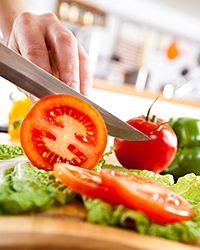 “Salads are an easy way to use up your harvest – but they’re not the only way.iStockphoto/Thinkstock
“Salads are an easy way to use up your harvest – but they’re not the only way.iStockphoto/Thinkstock
You could spend lots of time and energy planting a garden that’s purely for show – or you could focus your efforts on edible gardens, blooming with tomatoes, berries, herbs, and even flowers that will provide you with a summer’s worth of delicious salads, desserts, and other dishes – plus plenty of extra fruits and vegetables that you can preserve for the winter. Start with these common edible plants and easy recipes that let you really appreciate your garden.
Contents
- Herbs
- Tomatoes
- Strawberries
- Zucchini
- Peas
- Bell Peppers
- Flowers
Herbs
Fresh herbs may just be the easiest kind of plant to grow; even if you don’t have any space outdoors, you can grow them in containers, on a windowsill, or even in a hydroponic garden. They’re also almost ridiculously versatile: You can use them fresh, dried, or pureed, over vegetables and pasta, on roasted meats, or in desserts and drinks.
Try them in: Strawberry and Basil Bruschetta, Martha Stewart’s Raspberry Herb Cocktail, Ina Garten’s Herb Marinated Pork Tenderloins, Rosemary Orange Ice Cream.
Tomatoes
If you’re hoping to have fresh, red, juicy tomatoes straight from your garden, you’ll need to plant them in a spot that gets plenty of sun and where the soil drains well – and in a region where temperatures don’t go much higher than about 85 degrees. Some types of tomatoes will need to be harvested all at once, so those varieties are often better for canning and preserving, while others will continue to grow throughout the summer.
Try them in: Tomato Soup; Fried Green Tomatoes; Pesto-Pasta Stuffed Tomatoes; Tomato Risotto.
Strawberries
For a bumper crop of strawberries that continues throughout the summer, install your plants in areas of full sun and moist soil. If you don’t have the space to dedicate to planting a strawberry garden in the ground, then try using strawberry jars or other small containers to make the most of a patio, porch, or balcony. (But keep in mind that the animals in your yard find strawberries just as delicious as you do, and you may need to add netting to get any for yourself.)
Try them in: Chocolate Dipped Strawberries; Buddy’s Strawberry Shortcake; Spinach & Strawberry Salad; Strawberry-Apricot Barbecue Cornish Hens.
Zucchini
Give your zucchini plenty of space to spread out and tons of sunlight and you just might end up with more of these tasty green squashes than you know what to do with – but that’s not necessarily a bad thing when this summer squash has so many uses. Zucchinis have a mild flavor that means you can add them to any veggie-based dish (like pasta or soup) but they can also stand on their own when stuffed, sautéed, or roasted. They’re even a great base for cakes, cookies, and other baked goods.
Try them in: Zucchini Cakes; Emeril’s Green Beans and Zucchini with Garlic; Zucchini Bread; Lemon-Zucchini Cornmeal Cookies.
Peas
Climbing green pea vines are a pretty addition to your backyard garden, but for the maximum harvest you’ll need to plant them early – they thrive when temperatures are in the low 60s – and need rich, well-drained soil. You’ll have peas ready to eat in about 7-10 weeks; just in time to add them to light summer meals like stir fries, pastas, frittatas, salads, and more.
Try them in: Shrimp Snow Peas with Rotini; Green Pea Rice Amandine; Stir-Fried Rice with Egg, Mushrooms, and Green Peas.
Bell Peppers
How Stuff Works recommends starting your pepper plants indoors about eight weeks before you want to move them outside, where you should place them in full sun after the last frost. Prefer your peppers red or yellow as opposed to green? Let them stay on the plant longer: The reds are the most ripe, while the greens are picked before they reach their full color.
Try them in: Grilled Red Bell Pepper Dip; Turkey Sandwiches with Roasted Bell Peppers; Lighter Stuffed Peppers; Three Pepper Steak.
Flowers
Many of the same flowers that add those much-loved pops of color to your garden can add taste and color to your plate, too. Edible flowers include carnations, geraniums, daylilies, sunflowers, roses, and marigolds, and these (plus many others) are surprisingly delicious when fried, added to salads, or used to flavor ice cream. But before you dig in, make sure the blooms you are eating aren’t poisonous.
Try them in: Dandelion Quiche; Flower Honey; Rose Petal Ice Cream; Batter-Dipped and Fried Flowers.
Lots More Information
More Great Links
- How to Grow an Herb Garden
- How to Eat Flowers
- How to Start a Garden
Sources
- “Easy Vegetarian Recipes.” TreeHugger. (June 20, 2013) http://www.treehugger.com/easy-vegetarian-recipes/
- “66 Favorite Herb Recipes.” Martha Stewart. (June 20, 2013) http://www.marthastewart.com/274306/favorite-herb-recipes/@center/276995/marthas-culinary-herb-garden#275149/314545
- “Herb-Marinated Pork Tenderloins.” Food Network. (June 20, 2013) http://www.foodnetwork.com/recipes/ina-garten/herb-marinated-pork-tenderloins-recipe/index.html
- “Fresh herbs make sweet and sophisticated ice cream.” Oregon Live. (June 20, 2013) http://www.oregonlive.com/foodday/index.ssf/2008/06/recipe_detail.html?id=7484
- “Growing tomatoes.” How Stuff Works. (June 20, 2013) https://home.howstuffworks.com/tomatoes1.htm
- “Cooking.” TLC. (June 20, 2013) https://recipes.howstuffworks.com/
- “Zucchini Bread.” Smitten Kitchen. (June 20, 2013) http://smittenkitchen.com/blog/2007/07/summer-of-the-bats/
- “We’re Eating Flowers.” Frugal Mama. (June 20, 2013) http://www.frugal-mama.com/2012/07/were-eating-flowers-that-are-pretty-and-delicious-our-3-favorite-recipes-by-virginia-suardi-8-years-old/
- “42 Flowers You Can Eat.” TreeHugger. (June 20, 2013) http://www.treehugger.com/green-food/42-flowers-you-can-eat.html



























